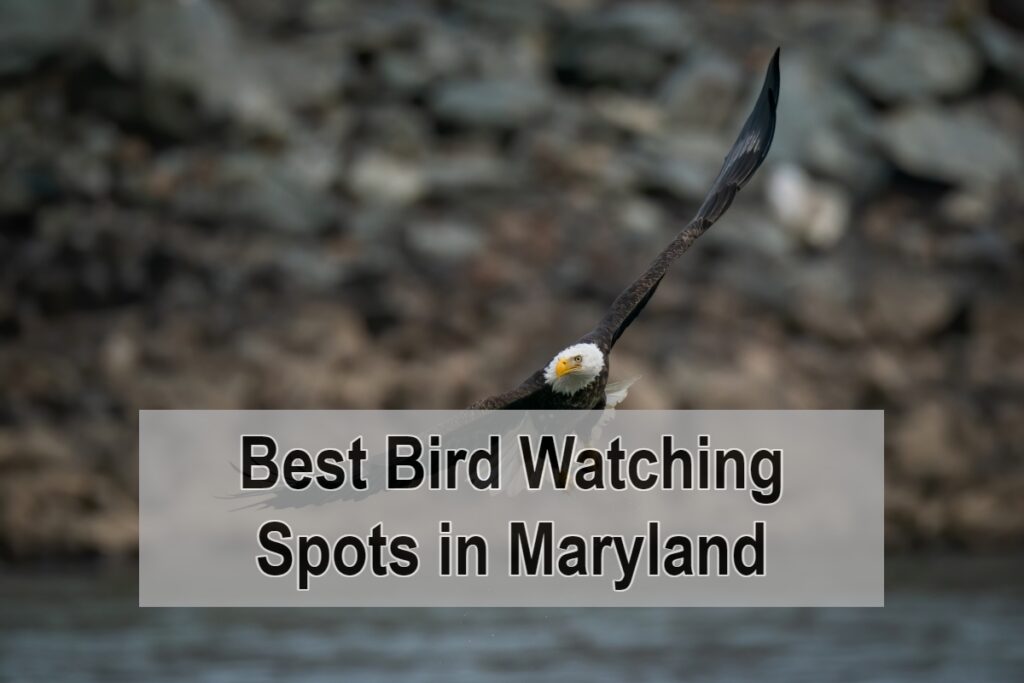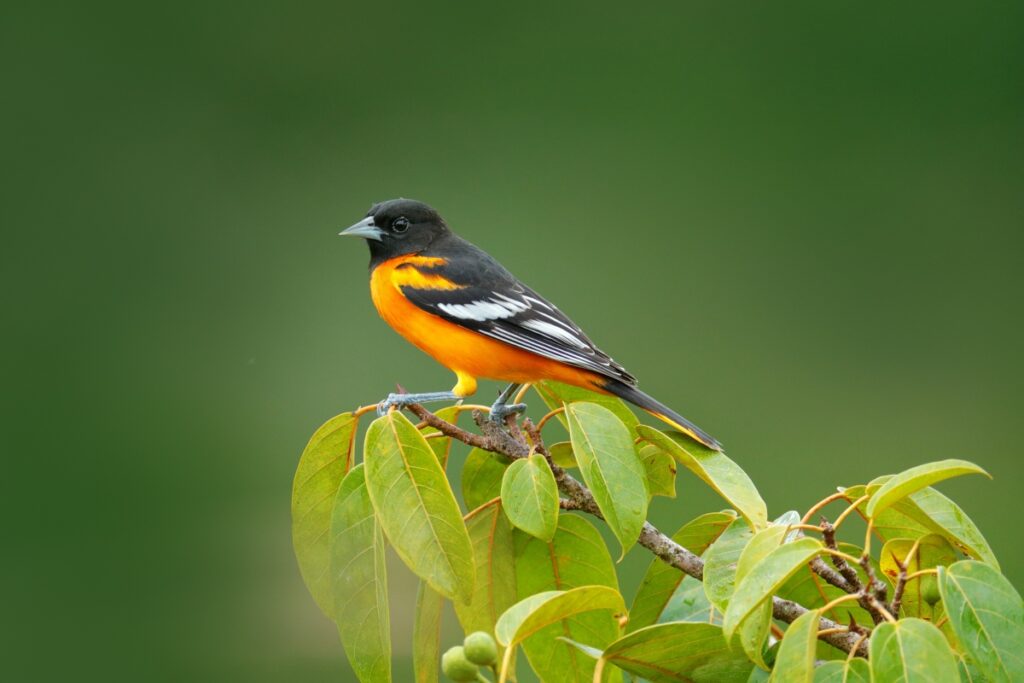As an Amazon Associate, we earn from qualifying purchases with no additional costs for you.
Maryland is a mid-Atlantic state that has a lot to offer for bird watchers. There is a range of habitats for birds that you can visit. It may be tricky to know the best spots, though, which is why I compiled this list of best spots for birders in Maryland.
The best bird watching spots in Maryland are those on the Chesapeake Bay, such as Sandy Point State Park, Fort Smallwood, and Point Lookout State Park. Sites like Pickering Creek Audubon Center and Eastern Neck National Wildlife Refuge have many habitats, attracting several bird species.
Table giving the most exciting birds you can see at each of my top 11 birding spots in Maryland:
| PARK | INTERESTING BIRDS YOU CAN SEE |
|---|---|
| Sandy Point State Park | Great Cormorant and Northern Gannet |
| Point Lookout State Park | Brown Pelican and Snowy Egret |
| Assateague Island National Seashore | Osprey and Piping Plover |
| Fort Smallwood Park | Sharp-shinned Hawk and Red-shouldered Hawk |
| Eastern Neck National Wildlife Refuge | Canvasback and Virginia Rail |
| The Chesapeake and Ohio Canal National Historical Park | Common Merganser and Canada Goose |
| Dierssen Waterfowl Sanctuary and Blockhouse Point Park | Green Heron and Wood Duck |
| Blackwater National Wildlife Refuge | Bald Eagle and King Rail |
| Pickering Creek Audubon Center | Tundra Swan and Northern Harrier |
| Eastern Neck National Wildlife Refuge | Canvasback and Ruddy Duck |
| Swallow Falls State Park and Herrington Manor | Ruffed Grouse and Blue-headed Vireo |
Read on for information on what the best birding places are in Maryland. I also describe which bird species you can look out for and expect to find in each spot.
TIP: If you want to check out the best pair of binoculars for bird watching, we recommend a pair of waterproof and fog-proof 8 x 42 binoculars like the Celestron – Outland X 8×42 Binoculars (Amazon link).
Best Places to Bird Watch in Maryland
At least 442 bird species have been recorded in Maryland because there is a diversity of habitats providing feeding, nesting, and resting opportunities for birds.
1. Sandy Point State Park
Sandy Point State Park is a 786-acre area situated on the Chesapeake Bay. Besides the waters of the bay, there are also beaches and forests to bird in. This park has an impressive list of 300 bird species.
The park tends to be busy in summer, so most bird watchers prefer visiting in winter. This is also the best time to see uncommon oceanic birds, like the Iceland Gull and Black-legged Kittiwake.
In winter, you can look for Northern Gannets and Great Cormorants here. Ospreys and Bald Eagles have also been recorded in this area.
Red-necked Grebes, Wood Ducks, and Pied-billed Grebes have been observed in the waters. Look out for Bonaparte’s Gulls, Caspian Terns, and Royal Terns over the bay and on the beach.
You can find species such as Indigo Buntings, Blue Grosbeaks, and Yellow Warblers in the forest. Northern Saw-whet Owls have been observed in the park, as have Northern Bobwhites. Chipping Sparrows, Song Sparrows, and White-throated Sparrows can also be seen in the park.
TIP: Knowing how to spot the birds in your yard is key to enjoying visits from your winged friends as much as possible! The best sources are trusted books, I recommend using the following (Amazon links):
– National Geographic Field Guide to the Birds of North America
– National Audubon Society Birds of North America
2. Point Lookout State Park
This park is on a peninsula where the Chesapeake Bay and Potomac River come together. The position of this park means it is suitable for migrating birds, which frequently stop over here to rest and feed before continuing with their journeys.
The habitats here include open waters, beaches, rocky areas, grasslands, deciduous woodlands, and pine woodlands.
The waters here are great for waterfowl like loons, grebes, and ducks. You can see Great Cormorants and Brown Pelicans. You can also see waders like Great Blue Herons, Snowy Egrets, and Great Egrets.
The woodlands are good for finding woodpeckers, vireos, warblers, and flycatchers. In the park, you can find species like the Least Flycatcher and Willow Flycatcher—the White-eyed and Red-eyed Vireo nest.
Woodpeckers to search for include the Pileated Woodpecker, Red-bellied Woodpecker, Hairy Woodpecker, and Downy Woodpecker. Several species of swallows and Fish Crows are also found in the area.
3. Assateague Island National Seashore
This is situated on a barrier island in the Atlantic Ocean. It is a terrific bird watching spot that I enjoy visiting. There are many birds you can see here.
In winter, you can see Brant, Scoters, and Great Cormorants. The Brants can occur in their hundreds during winter. There are also dunes and forests, besides the beaches and open water of the ocean.
Summer species to look out for at Assateague Island include Clapper Rails and Ospreys. The site is an important place for Piping Plovers, which breed here on the beaches from spring through the end of summer.
During fall migration, you may spot several warbler species in the trees of the forested areas. The area is on the Atlantic flyway for bird migration.
It would be best if you chose the Life of the Marsh boardwalk nature trail for a birding hike here. This is located at the Bayside Peninsula. There is a checklist of the island’s bird species that you can download and print for use on your trip.
4. Fort Smallwood Park
This park is also on a peninsula where the Chesapeake Bay and Patapsco River unite. This 90-acre park has a reputation for being good for seeing hawks during migration in spring.
March through to May is an excellent time to see raptors like the Red-shouldered Hawks, Cooper’s Hawks, Ospreys, Bald Eagles, and Sharp-shinned Hawks.
The park is good for more than just raptors, with at least 269 species recorded. You can access and use a checklist for this birding hotspot.
Spring is a good time also for seeing many migrating songbirds. Some songbirds seen here include Chestnut-sided Warblers, Yellow Warblers, Black-throated Green Warblers, and Blackpoll Warblers.
You can find several waterfowl in the open waters here, including species such as Red-throated Loons, Red-necked Grebes, Wood Ducks, Ruddy Ducks, Long-tailed Ducks, Ring-necked Ducks, Horned Grebes, Lesser Scaup, Surf Scoter, and Buffleheads.
5. Eastern Neck National Wildlife Refuge
Eastern Neck National Wildlife Refuge is 2,285 acres in size and is situated on an island. The refuge provides a range of bird habitats, including ponds, upland forests, grasslands, and brackish marshes.
There are trails, viewing platforms, and blinds set up for people to use when viewing birds. Some trails may be closed when Bald Eagles are nesting, though.
Tundra Swans are common here from November to March each year. There is a viewing platform specifically set up for people to look at the swans. Look in the marshy areas for Virginia Rails and Marsh Wrens.
Several waterfowl species can be seen here, including Canvasbacks, American Wigeon, American Black Duck, Northern Pintail, and Bufflehead.
6. The Chesapeake and Ohio Canal National Historical Park
Along the canal, there are two locks, Violettes Lock and Pennyfield Lock, which are helpful for bird watchers because the water level is such that it attracts a bigger range of birds than in some other places.
Several waterfowl species are in the area, such as the Mallard, Common Merganser, and Canada Goose. The Chesapeake and Ohio National Historical Park has a record of at least 120 bird species.
TOP TIP: Understanding the best practices for birding according to season and what birds may be likely to eat in certain seasons are critical aspects of bird watching that can help improve your ability to find the birds you are after.
TIP: Are you looking for high-quality food for wild birds on your backyard? I recommend using Wagner’s products with the highest quality grains used in blending and made in the USA (Amazon links):
– Deluxe Treat Blend Wild Bird Food
– Eastern Regional Wild Bird Food
– Western Regional Wild Bird Food
– Midwest Regional Wild Bird Food
– Southern Regional Wild Bird Food
7. Dierssen Waterfowl Sanctuary and Blockhouse Point Park
This area is 40 acres in size and is accessible by walking along the same paths in the Chesapeake and Ohio Canal National Historical Park area. The sanctuaries have several birds present; 260 species have been recorded here.
The marshland attracts various birds, including Wood Ducks, which breed in the area. You can see waders and shorebirds on the shoreline and where water levels are low. For instance, you can find Great Egrets, Spotted Sandpipers, and Green Herons.
This region has also observed double-crested Cormorants, Bald Eagle, and Osprey. Songbird species to look for in the refuge include the Baltimore Oriole, Louisiana Waterthrush, Scarlet Tanager, Yellow-throated Warbler, and Prothonotary Warbler.
8. Blackwater National Wildlife Refuge
This refuge is 28,000 acres in size. This is the place to spot nesting Bald Eagles. You can see the eagles by taking the 4-mile drive around the refuge or even standing at the visitor’s center. The refuge has freshwater lakes and tidal marshes.
King Rails and American Bitterns breed in the marshy areas here so you can look for these birds. The best time to see these two species is at dawn and dusk. This refuge also attracts thousands of geese in winter. Snow Geese and Tundra Geese often overwinter here, as do many ducks and swans.
The refuge is also suitable for seeing the Seaside Sparrows and Grasshopper Sparrows. You should keep watch for Golden Eagles and Peregrine Falcons, which people have recorded in the refuge.
The loblolly pine trees of Blackwater National Wildlife Refuge are an excellent place to look for Red-breasted Nuthatches.
9. Pickering Creek Audubon Center
This is a 400-acre area that has a range of habitats for birds. The habitats here include brackish marshes, freshwater marshes, wetland areas, and hardwood forests. The site has 4 miles of trails, various blinds, and observation decks that birders can use while searching for bird species.
The area has recorded about 240 bird species. The site is an excellent place to see Tundra Swans. Grasslands here are a good spot for finding Bobolinks and Northern Harriers.
10. Eastern Neck National Wildlife Refuge
This refuge is 2,285 acres in size. This refuge has many trails and roads to drive while looking for birds. Tundra Swans are present and overwinter in the refuge and can be seen from one of the viewing platforms.
Both Ospreys and Bald Eagles can be seen in the refuge, although Osprey is not present year-round. You can see Virginia Rails in the marshland and various ducks on the water.
Waterfowl species to look for include American Black Duck, Canvasback, Ruddy Duck, Blue-winged Teal, American Wigeon, Bufflehead, and Long-tailed Duck.
11. Swallow Falls State Park and Herrington Manor
This area is known for having many birds because of the mixed forest of hemlock, pine, and hardwood trees. The birds to watch out for include Ruffed Grouse, Acadian Flycatcher, Blue-headed Vireo, American Redstart, Blackburnian Warbler, and Black-throated Green Warbler.
You can also see Brown Creepers, Hermit Thrushes, Wood Thrushes, and Ovenbirds. The thrushes may often be low down in the vegetation or running along the ground. Ruffed Grouse are pretty secretive and will also be on the ground. It is wise to look at all levels of vegetation when bird watching.
Best Time to Bird Watch in Maryland
Maryland is a good bird watching state regardless of the time of year you visit, but some birds, like oceanic species, are most often seen in winter.
| TYPES OF BIRDS | SEASON |
|---|---|
| Kittiwake and Brant | Winter |
| Osprey | Summer |
The Maryland State Bird
The Maryland State Bird is the Baltimore Oriole (Icterus galbula). This bird is a summer migrant easily identified because of its bright, bold colors.
Male orioles are bright yellowy-orange with black heads and black and white on the wings. Females are duller colors and do not have the black head of the male. Both sexes have quite long, sharp beaks.
The birds are about 6 to 8 inches in size with long legs. Baltimore Orioles have a distinctive song and call and are easy to attract to fruit feeders. If you put out slices of orange in spring and summer, you may attract an oriole or two to your garden.
Bird Watching Laws in Maryland
Wild indigenous birds are protected, and you may not possess, catch, hunt, or harm any birds except for those, such as game birds, where hunting is allowed during specific open seasons.
My Favourite Equipment for Bird Watching
Bird watching is one of the least expensive hobbies out there, but you still need some equipment to get the most out of it.
The essential equipment to start bird watching is a pair of binoculars. My preference is 8 X 42 binoculars. The number 8 is how much the magnification is, while 42 is the field of view in millimeters of the lenses.
A pair of waterproof and fog-proof 8 x 42 binoculars like the Celestron – Outland X 8×42 Binoculars on Amazon is an excellent choice for both beginners and experts.
In time, you can choose more expensive models and also opt to buy a spotting scope like the Celestron Ultima 80 on Amazon.
These are a lot more expensive compared with binoculars though, so if you are only a beginner, start with binoculars first. A spotting scope is only helpful for birds far away, such as out on a pond or seashore.
There are a few rules or guidelines you should abide by as an ethical birder. These are listed below.
- Do not enter private lands without prior permission from landowners.
- Follow all the rules in refuges and reserves, including cleaning up any garbage from your campsite.
- Do not disturb birds on nests.
- Do not use apps and play songs to call up birds when they are hungry, tired, and breeding during spring and summer.
Conclusion
Maryland is not a large state but has many benefits for bird watchers, including the Chesapeake Bay. Many migrating birds stop over on the bay’s shores, and many of my best birding spots are on the shores of the Chesapeake Bay.
There is also a range of habitats found in the refuges and parks of the state. Maryland is always a good choice for anyone interested in seeing birds and adding them to their life list.
TIP: If you want to check out the best pair of binoculars for bird watching, we recommend a pair of waterproof and fog-proof 8 x 42 binoculars like the Celestron – Outland X 8×42 Binoculars (Amazon link).


